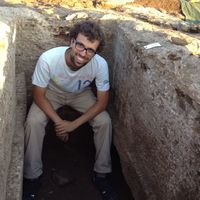Leonardo Bison
University of Bristol, Archaeology and Anthropology, Graduate Student
Research Interests:
Resistances, changes and identities in Sardinian necropoleis during the early Punic era. Resumen: Desde el final del siglo VI y el siglo IV a. C., la isla de Cerdeña conoce la conquista por parte del poder car-taginés y,... more
Resistances, changes and identities in Sardinian necropoleis during the early Punic era.
Resumen: Desde el final del siglo VI y el siglo IV a. C., la isla de Cerdeña conoce la conquista por parte del poder car-taginés y, consecuentemente, una amplia migración desde Carthago y el Noroeste de África. Esos eventos producen un cambio profundo y sorprendente en la cultura material de la isla, cambio que se desarrolla rapidamente en unas decadas después del comienzo de la ocupación cartaginesa. En este articulo, que llega seguido de un estudio extensivo de los datos, hemos tratado de reordenar y reinterpretar todos los datos disponibles sobre los rituales, las tumbas y el mundo funerario en el primer siglo de presencia púnica en Cerdeña. Ilustraremos los elementos más relevantes del mundo funerario de la Cerdeña púnica, subrayando lo que va cambiando y lo que sigue igual desde la edad fenicia, y trataremos de explicar como es posible detectar en las necrópolis elementos materiales y culturales no púnicos, sino conectados con culturas diferentes, como las norteafricanas y bereberes. Finalmente enseñaremos las profundas diferen-ciaciónes que existen entre las distintas necrópolis de la isla, que podrían ser huellas de divergencias no solamente materiales, sino también étnicas y culturales, entre las comunidades. Este estudio quiere aclarar la complejidad y variedad cultural existente en la Cerdeña punica, que revela identidades distintas, indígenas y foráneas, cubiertas por una cultura funeraria y material que solo aparen-temente es homogénea y simplemente púnica.
Abstract: Between the 6th and the 4th century B.C., the island of Sardinia became a site of a significant migration from Western North Africa, due to the conquest of the island by the growing Carthaginians. This conquest brought a profound and significant change to the material culture of the island, developed in a few decades after the conquest. In this paper, through an extensive study and reinterpretation off all available data surrounding the mortuary rites and the funerary world in the first century of the Punic presence in Sardi-nia, we tried to list the most important features in the funerary world of Punic Sardinia, underlining what has changed and what was persisting after the Punic colonization; then we attempted to explain how is possible to recognize in the necropolis, elements concerning cultures that were not Punic, such as the North-African and Berber cultures, and the significant differences and gaps between the necropolis and the communities of the island: differences and gaps which are possibly suggesting the existence of ethnic and cultural peculiarity. This study shows a complex and varied cultural reality in Sardinia, revealing indigenous and foreign identities, covered by apparently a homogeneous Punic material and funerary culture.
Resumen: Desde el final del siglo VI y el siglo IV a. C., la isla de Cerdeña conoce la conquista por parte del poder car-taginés y, consecuentemente, una amplia migración desde Carthago y el Noroeste de África. Esos eventos producen un cambio profundo y sorprendente en la cultura material de la isla, cambio que se desarrolla rapidamente en unas decadas después del comienzo de la ocupación cartaginesa. En este articulo, que llega seguido de un estudio extensivo de los datos, hemos tratado de reordenar y reinterpretar todos los datos disponibles sobre los rituales, las tumbas y el mundo funerario en el primer siglo de presencia púnica en Cerdeña. Ilustraremos los elementos más relevantes del mundo funerario de la Cerdeña púnica, subrayando lo que va cambiando y lo que sigue igual desde la edad fenicia, y trataremos de explicar como es posible detectar en las necrópolis elementos materiales y culturales no púnicos, sino conectados con culturas diferentes, como las norteafricanas y bereberes. Finalmente enseñaremos las profundas diferen-ciaciónes que existen entre las distintas necrópolis de la isla, que podrían ser huellas de divergencias no solamente materiales, sino también étnicas y culturales, entre las comunidades. Este estudio quiere aclarar la complejidad y variedad cultural existente en la Cerdeña punica, que revela identidades distintas, indígenas y foráneas, cubiertas por una cultura funeraria y material que solo aparen-temente es homogénea y simplemente púnica.
Abstract: Between the 6th and the 4th century B.C., the island of Sardinia became a site of a significant migration from Western North Africa, due to the conquest of the island by the growing Carthaginians. This conquest brought a profound and significant change to the material culture of the island, developed in a few decades after the conquest. In this paper, through an extensive study and reinterpretation off all available data surrounding the mortuary rites and the funerary world in the first century of the Punic presence in Sardi-nia, we tried to list the most important features in the funerary world of Punic Sardinia, underlining what has changed and what was persisting after the Punic colonization; then we attempted to explain how is possible to recognize in the necropolis, elements concerning cultures that were not Punic, such as the North-African and Berber cultures, and the significant differences and gaps between the necropolis and the communities of the island: differences and gaps which are possibly suggesting the existence of ethnic and cultural peculiarity. This study shows a complex and varied cultural reality in Sardinia, revealing indigenous and foreign identities, covered by apparently a homogeneous Punic material and funerary culture.
